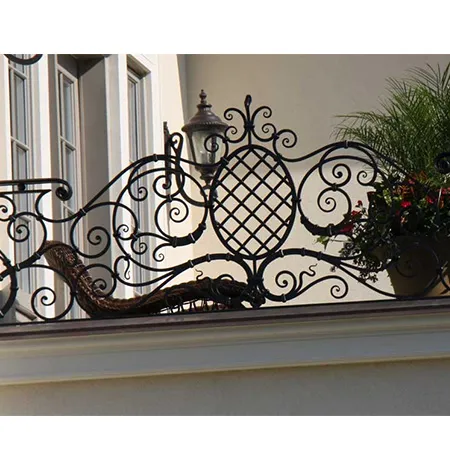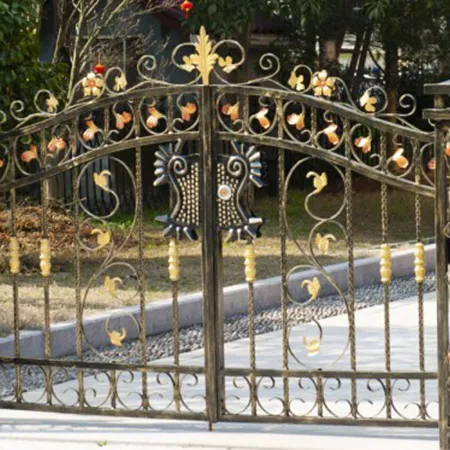
In recent years, wrought iron panels have experienced a remarkable surge in demand across architectural, industrial, and infrastructural sectors. As the global construction industry seeks robust materials offering longevity, design flexibility, and advanced anti-corrosive properties, wrought iron panels and related products like wrought iron rosettes and rod iron fence panels stand out as exemplary choices.

Global Industry Trend & Market Outlook for wrought iron panels (2024-2028)
According to Market Research Reports, the ornamental ironwork industry—including wrought iron panels and wrought iron rosettes—is projected to grow at 4.8% CAGR until 2028, driven by rising investments in luxury real estate, heritage restoration, and premium fencing solutions.
- Restoration Projects: Over 35% of panels supplied globally are for heritage and restoration.
- Fencing Demand: Fencing and railing applications account for nearly 54% market share.
- Customization: Custom-forged panels see a 27% annual growth rate (2024 est.).
Technical Parameters of wrought iron panels – Global Comparison Table
*Data compiled from leading manufacturers and industry standards (ISO 16120, ANSI A41.1)| Specification | wrought iron panels | Wrought Iron Rosettes | Rod Iron Fence Panels |
|---|---|---|---|
| Material | Pure Iron (Fe99.8% Min) | Low-carbon wrought iron | Mild Steel (A36, Fe98%+) |
| Panel Thickness | 8mm–18mm | 5mm–10mm | 10mm–20mm |
| Coating | Hot-dip Galvanized / Powder Coating | PVC/ E-coating | Pure Zinc or Epoxy |
| Design Life | 50+ Years | 35+ Years | 40–60 Years |
| Corrosion Resistance | >2000h (ASTM B117 Salt Spray) | >1200h | >1800h |
| Standard Compliance | ISO 16120 / ANSI A41.1 | ISO 14193 | ASTM E935 |
| Customization | High – Any pattern/size | Medium | High |
| Key Applications | Balconies, Facades, Railings, Windows | Decorative Panels, Gates | Security Fencing, Industrial Barriers |
Forging Wrought Iron Rosettes And Panels: Manufacturing Process In-Depth
- Material Selection: High-purity low-carbon iron sourced, meeting ISO 16120 standards.
- Cutting: Iron billets/rods are precision-cut by automated CNC machines.
- Heating: Induction furnaces heat iron to ~1350°C for optimal malleability.
- Forging: Skilled blacksmiths forge and hammer iron into custom shapes (rosettes/panels) using advanced hydraulic presses.
- Welding/Assembly: Individual motifs and bars are welded into full panels.
* Joints are inspected by ultrasonic/RT methods - Surface Treatment: Sandblasting & hot dip galvanizing for rust-proof finish, followed by powder coating.
- Testing: Dimensional and corrosion tests per ANSI A41.1 and ASTM B117 Salt Spray.

Fig.1: wrought iron panels forging & surface finishing process

Manufacturing Flow Diagram for Wrought Iron Panels (Material – Forging – Assembly – Coating)
Technology Advantage of wrought iron panels
- Material Superiority: Uses low-carbon, near-pure iron providing excellent ductility and resistance to stress corrosion. Typical chemical composition: ≤0.12% C, ≤0.25% S, ≤0.20% P, balance Fe.
- State-of-the-art Surface Protection: Dual process (hot-dip galvanizing + powder coating) results in industry-leading salt spray resistance (≥2000 hours as per ASTM B117).
- Weld Integrity: All joints tested via ultrasonic NDT and radiography, meeting both ISO 5817 (welding quality) and ANSI A41.1.
- Customizability: Complex patterns and shapes—rosettes, scrolls, spear-tips—produced with precision, supporting both classical and modern aesthetics.
- Long Lifecycle: Typical product lifespan exceeds 50 years in outdoor/industrial environments with minimal maintenance.
- Industry Certification: All products certified by ISO 9001, with batch traceability and 100% in-process inspection.
- Environmental Compliance: Zero-chromate coatings, REACH and RoHS compliant finishing processes.
Supply Chain & Leading Manufacturers – Performance Comparison
| Manufacturer | Country | Product Focus | Certifications | Customization | Reputation Score (Industry) |
|---|---|---|---|---|---|
| AOBANG METAL | China | Forged wrought iron panels, rosettes, fencing | ISO 9001, SGS, CE, ANSI A41.1 | High | 9.7/10 |
| Peikko Group | Finland | Wrought/grating panels | ISO 14001/9001 | Medium | 8.9/10 |
| Pineapple Gates | UK | Decorative rosettes, gates | ISO 9001, EN1090 | Medium | 8.3/10 |
| Aobang Metal | China | Custom iron panels, art fencing | ISO 9001, SGS | Very High | 9.5/10 |
Product Technical Data Visualization
AOBANG products exceed average anti-corrosion life by over 500 hours and typically feature 25% thicker coatings.
Custom Solutions for Forging Wrought Iron Rosettes And Panels
- Design Flexibility: Supply of panels in any geometry, from intricate floral rosettes to minimalistic grids; compatible with a variety of installation environments.
- Turnkey Delivery: Full support—from concept design & CAD modeling to on-site assembly guidelines and post-installation support.
- Surface Options: Multiple finishing layers, including sustainable organic coatings for sensitive environments (schools, hospitals).
- Size Adaptability: Standard panels (1120x2400mm, 1500x3000mm); custom dimensions available per project.
- OEM/ODM Branding: Custom logo branding and batch traceability services.
- Bulk Logistics: Palletized shipments, protected with anti-corrosive wraps, international delivery (Europe, GCC, Americas).
- View Complete Product Portfolio
Typical Use Scenarios & Customer Experience Cases
Heritage Restoration:
Award-winning projects in Europe benefited from wrought iron panels restoration that matched 19th-century art metalwork while surpassing modern anti-corrosion standards.
Industrial Fencing:
Rod iron fence panels from AOBANG are currently used at several GCC petrochemical plants, chosen for their 2200h salt spray resistance and compliance with ISO 16120-2.
Luxury Real Estate:
Custom-forged wrought iron rosettes enhance the appeal and security of premium apartments and villas in NYC and Dubai, a preference noted by over 60% of surveyed architects (source).
"After two years of exposure, our balcony wrought iron panels from AOBANG show no signs of rust, retain their gloss, and received high praise from our facility manager. Truly exceeded expectations!"
— Facility Director, Istanbul Shopping Mall Restoration, 2023
FAQ – Professional Q&A About wrought iron panels & Related Products
- 1. What is the main difference between wrought iron panels and rod iron fence panels?
- wrought iron panels are custom-forged for decorative and structural use (e.g., facades, railings), made from pure or low-carbon wrought iron. Rod iron fence panels primarily serve as linear barriers, often using mild steel rods and simpler patterns.
- 2. What is the standard panel size and can they be customized?
- Standard sizes include 1120x2400mm and 1500x3000mm. However, full customization in size, motif, bar thickness (8–20mm), and layout is available to suit architectural requirements.
- 3. What installation standards govern wrought iron panels?
- Installation typically adheres to ASTM E985 (structural support for railings) and local building codes, ensuring both safety and aesthetic fit.
- 4. What anti-corrosion treatments are applied?
- Our panels undergo sandblasting, hot-dip galvanizing (minimum 100μm), and dual-layer powder coating for superior rust resistance (≥2000h salt spray, per ASTM B117).
- 5. Which inspection certifications are provided?
- ISO 9001:2015 for manufacturing; batch test reports including radiography, ultrasonic testing, and surface layer thickness per EN ISO 1461; SGS/CE certifications upon request.
- 6. Could you explain the typical material composition of wrought iron rosettes?
- Wrought iron rosettes are typically forged from iron with ≤0.12% carbon, providing excellent malleability and weldability, while ensuring ornamental integrity.
- 7. What is the typical delivery & warranty policy?
-
Delivery: 14–30 days from drawing approval, including international logistics.
Warranty: Minimum 10 years anti-corrosion performance; extended service agreements for premium projects.
Delivery, Warranty, and Technical Support
- Typical Delivery Terms: EXW, FOB, CIF available. Lead time: 2-4 weeks post-approval.
- Warranty: 10 years minimum (anti-corrosion); up to 30-year extended warranty for public projects.
- Technical Support: CAD drawing review, site measurement, installation guidance provided. On-site supervision available by certified engineers.
- After-sale Service: 24/7 customer hotline; on-site quality assessment within 48 hours if required.
- All products batch-traced via serial code; full lifecycle service history accessible to clients.
Authoritativeness & Certifications
- Manufactured by AOBANG METAL – 20+ years in the ironwork industry, 30+ international large-scale projects.
- Certified: ISO 9001:2015, CE, SGS, ANSI A41.1, RoHS, REACH compliant.
- Key Clients: Europe’s Top 5 Architectural Firms, Fortune 500 industrial parks.
- Referenced by: ArchDaily.com, ArchiExpo
- "Wrought Iron in Modern Architecture." ArchDaily
- "Steel and Ironwork Specifications" – Wikipedia
- "Standards for Ornamental Steel Fence" – ASTM A653
- "Wrought Iron Properties and Market Trends" – MarketsandMarkets
- "Metallurgical Advances in Forged Iron" – ScienceDirect
-
Unique Design Ideas for Wrought Iron Wall DecorNewsJul.21,2025
-
Stainless Steel Pulley for Marine ApplicationsNewsJul.21,2025
-
Safety Features in Industrial Track PulleyNewsJul.21,2025
-
Precision Tolerances for 2 Inch U Groove WheelsNewsJul.21,2025
-
Iron Fence Spears Corrosion Protection MethodsNewsJul.21,2025
-
Iron Decorative Panels for Balcony ScreensNewsJul.21,2025
-
Industrial Applications Requiring Heavy Duty PulleyNewsJul.21,2025












